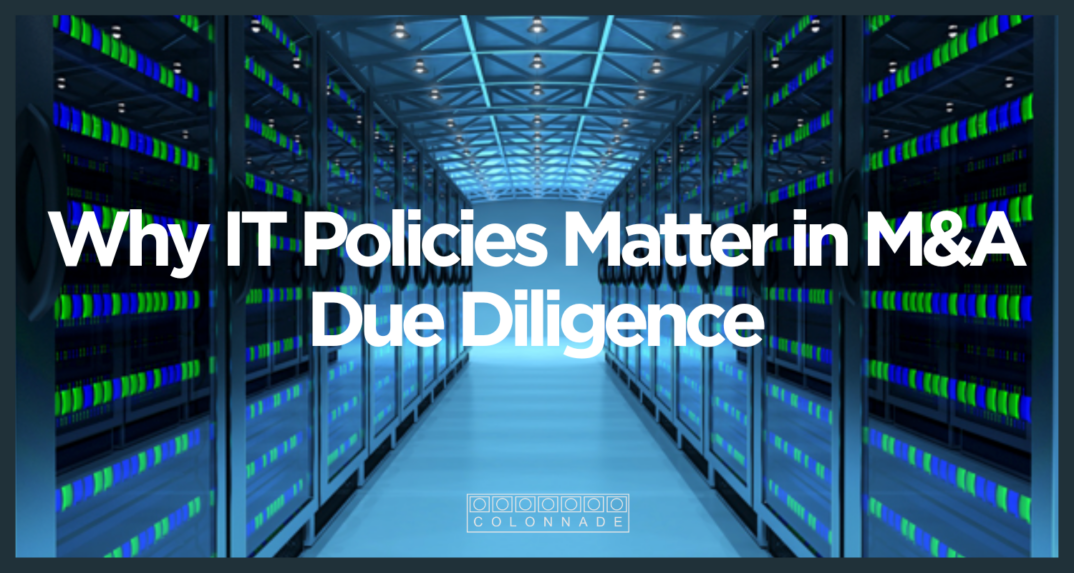Why IT Policies Matter in M&A Due Diligence

As M&A activity continues to accelerate in technology-enabled industries, buyers are becoming more sophisticated in how they assess operational risk—and one area under increasing scrutiny is IT governance. Beyond the hardware, software, and infrastructure diagrams lies a critical layer: the policies that govern how IT systems are used, protected, and maintained.
At Colonnade Advisors, we believe that IT policies are not just a compliance formality—they’re an indicator of maturity, scalability, and long-term value. In diligence, the presence (or absence) of documented IT policies can be a red flag or a green light.
What Are IT Policies?
IT policies are formalized guidelines and procedures that govern the management of information systems, user behavior, and cybersecurity. These documents shape how an organization handles access, security, risk, compliance, and even emerging technologies like AI.
Well-structured IT policies demonstrate that a company has considered not just “what” technology it uses—but “how” and “why” it uses it. Below is a breakdown of the core policies typically reviewed during M&A diligence and why each one matters.
Key IT Policies in M&A Due Diligence
1. Information Security Policy
Outlines the organization’s overarching commitment to protecting data and IT assets. This policy sets the tone for all other security-related documentation.
Why it matters: Demonstrates a top-down approach to cybersecurity. Lack of this policy often signals a fragmented or immature security posture.
2. Access Control Policy
Defines who can access systems, applications, and networks. Includes role-based access controls (RBAC), user provisioning, and termination procedures.
Why it matters: Prevents unauthorized access and data leaks. Investors want to see least-privilege principles and secure offboarding protocols in place.
3. Password Management Policy
Specifies password strength, rotation frequency, and the use of multi-factor authentication (MFA).E
Why it matters: Weak password controls are a common breach vector. Buyers look for standardized, enforceable controls to reduce risk.
4. Data Classification & Handling Policy
Establishes how sensitive, confidential, and public data is labeled, stored, and transmitted.
Why it matters: Enables proper safeguards for different data types, especially important for compliance-heavy industries.
5. Backup & Disaster Recovery Policy
Details backup schedules, retention periods, and procedures for system failures or disasters.
Why it matters: Business continuity is a critical diligence item. Buyers need to know how quickly systems can recover after an incident.
6. Privacy & Compliance Policy
Ensures the organization complies with regulations like GDPR, CCPA, HIPAA, PCI-DSS, and SOX.
Why it matters: Regulatory non-compliance can result in fines or post-close liabilities. This policy proves that compliance is intentional and systematic.
7. Incident Response Policy
Outlines how the organization identifies, reports, and manages cybersecurity incidents.
Why it matters: A company’s ability to respond quickly to threats can make or break operational continuity. Buyers want to see predefined response plans.
8. Acceptable Use Policy (AUP)
Specifies what employees can and cannot do with company IT resources, including internet and email usage.
Why it matters: Sets boundaries and reduces liability. It’s especially important in hybrid or remote-first environments.
9. Remote Work & VPN Policy
Covers secure remote access practices, including VPN configurations and endpoint protection for remote employees.
Why it matters: With hybrid work here to stay, this policy signals whether the company can securely scale beyond the office.
10. Wi-Fi & Network Security Policy
Sets guidelines for secure wireless access and internal network segmentation.
Why it matters: Helps identify if guest networks, employee access, and IoT devices are securely managed.
11. Software Installation & Licensing Policy
Controls the installation of third-party and open-source software, and manages software licensing compliance.
Why it matters: Ensures all software is authorized and legally compliant. Helps avoid audit risk and unknown dependencies.
12. Patch Management Policy
Requires timely updates to operating systems, applications, and security software.
Why it matters: Prevents exploitation of known vulnerabilities. Buyers want to see evidence of proactive risk mitigation.
13. Change Management Policy
Defines the process for requesting, reviewing, approving, and deploying changes to IT systems.
Why it matters: Reduces the chance of downtime or security issues caused by ad hoc system changes.
14. System Monitoring & Logging Policy
Details how IT environments are monitored for security threats, performance, and compliance.
Why it matters: Buyers want assurance that suspicious activity can be detected and investigated in real time.
15. Cloud Computing Policy
Governs the use of services like AWS, Azure, and Google Cloud, including data residency, cost management, and shared responsibility.
Why it matters: Demonstrates understanding of cloud governance—especially relevant for SaaS businesses.
16. IT Risk Management Policy
Identifies potential IT risks and documents mitigation strategies and risk tolerance thresholds.
Why it matters: Shows that leadership actively evaluates and manages technology-related threats.
17. Third-Party Vendor & Outsourcing Policy
Defines security, compliance, and performance expectations for external IT service providers.
Why it matters: Reduces exposure from third-party risks, a growing area of concern in due diligence.
18. Acceptable AI & Automation Policy
Establishes standards for deploying AI tools, bots, and automated decision-making.
Why it matters: Signals ethical and secure use of emerging technologies—critical for IP-rich or tech-forward companies.
19. IT Ethics & Responsible Use Policy
Covers the ethical use of IT systems, surveillance, analytics, and artificial intelligence.
Why it matters: Buyers want to understand not just the technical controls—but the ethical framework that governs them.
Final Takeaway: IT Policies Are a Proxy for Operational Maturity
During M&A due diligence, strong IT policies can shorten deal timelines, improve valuation, and build buyer confidence. Weak or missing policies often trigger additional diligence, risk assessments, or post-close integration challenges.
If your organization is preparing for a sale, or if you’re conducting diligence on a potential acquisition, ensure IT policies are up-to-date, accessible, and actionable. At Colonnade Advisors, we guide our clients through the IT evaluation process with a focus on value creation and risk management.
Want a checklist of must-have IT policies for diligence? Contact us. We’re happy to help.


